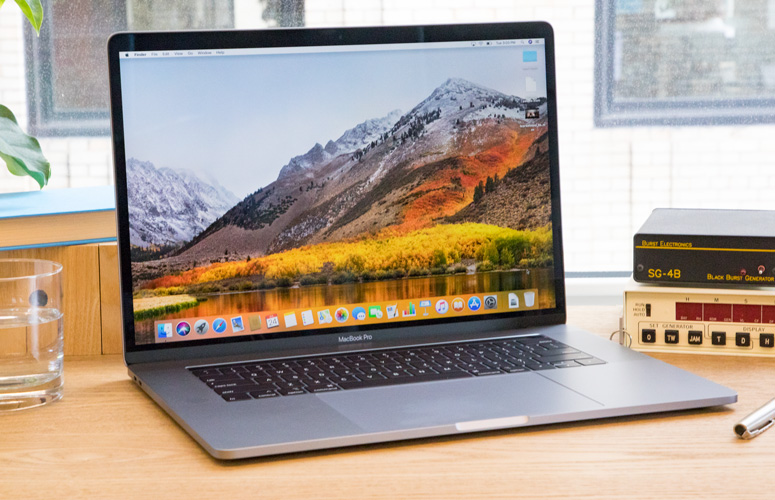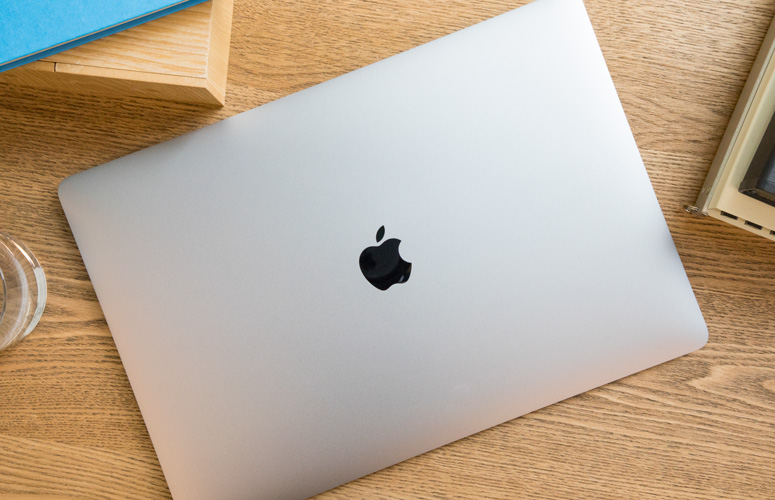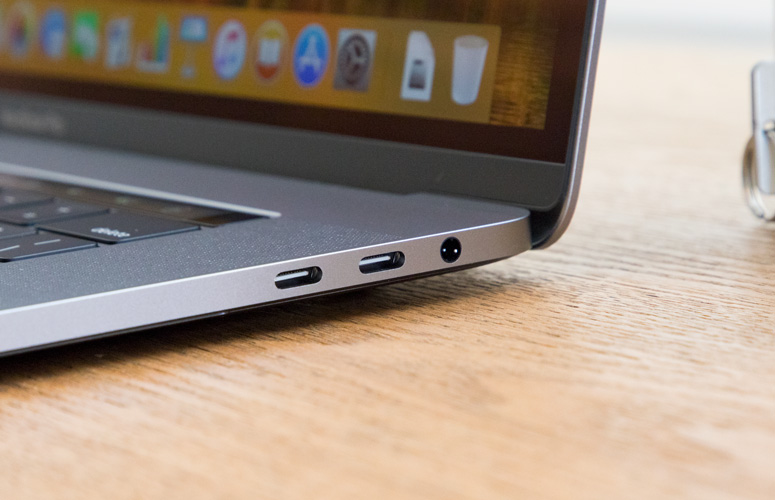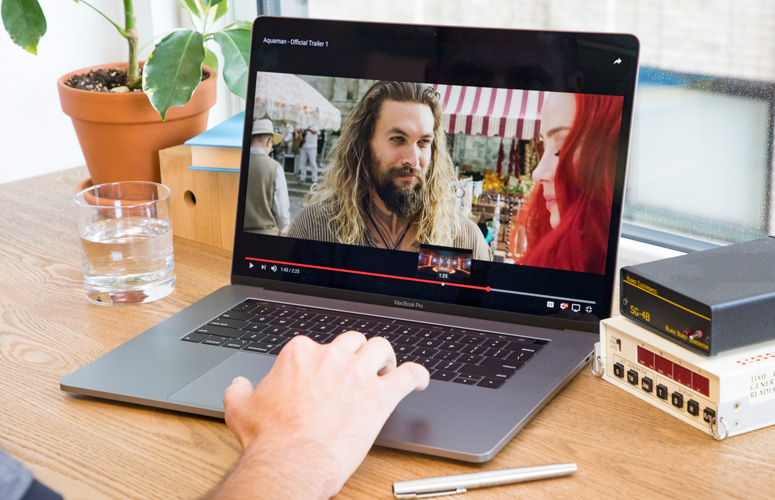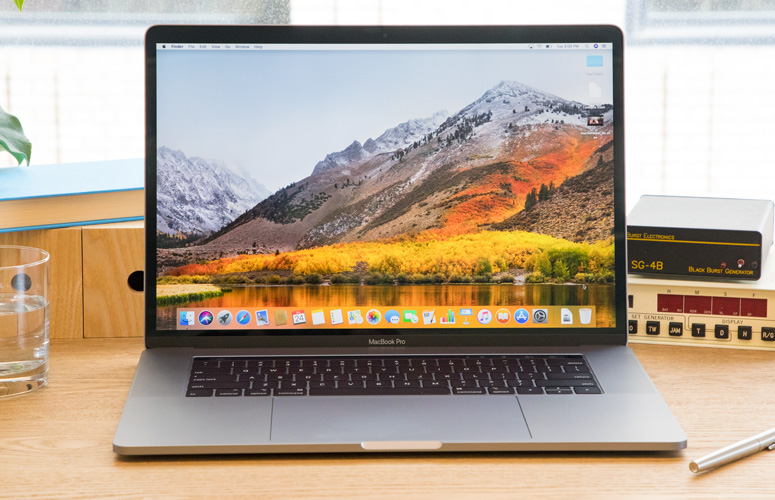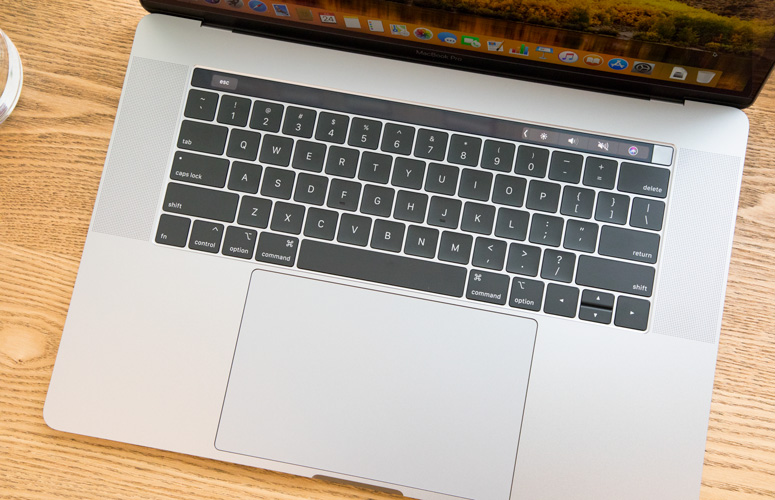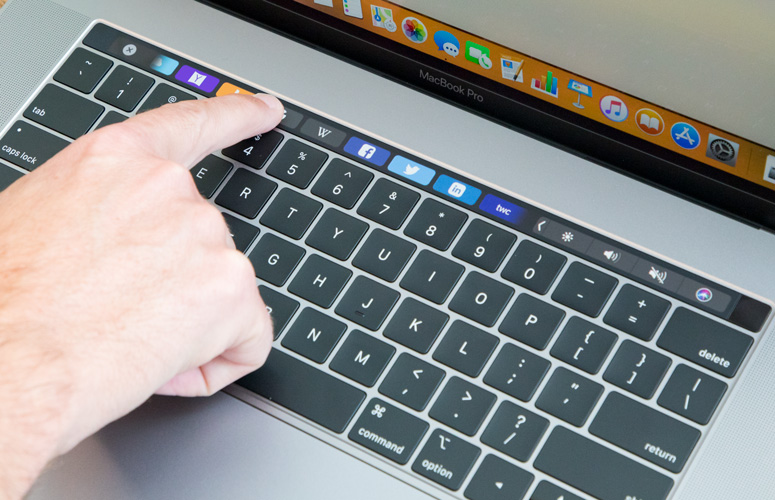Laptop Mag Verdict
The 15-inch MacBook Pro is one of the most powerful laptops we've ever seen and is worth the splurge for the most demanding creative pros.
Pros
- +
Insanely speedy general performance
- +
Fastest SSD we've tested
- +
Comparatively thin and light design
- +
Vivid, sharp display
- +
Improved keyboard
- +
Strong sound
- +
Long battery life
Cons
- -
Exorbitant price
- -
Warm underside
- -
No USB Type-A ports
Why you can trust Laptop Mag
May 21 Update: Apple's updated the MacBook Pro with 9th Gen and 8-Core CPU options, and its also tweaked its controversial keys.
Apple's new 15-inch MacBook Pro (tested at $4,699; starting at $2,399) has already seen dual controversies, but it's come out all-the-more-impressive for Apple. Not only have class-action lawsuits (1, 2) arisen about Apple's butterfly keyboard switches (the latest model seems to be more reliable), but a power-throttling bug was found and squashed, revealing some of the best laptop performance scores we've ever seen.
The big problem, though, is that this notebook's performance comes at a prohibitively expensive price. But with all of its power, in a thin and light (for its class) design, the new MacBook Pro is a force to be reckoned with. We even consider it to be one of the best video editing and best business laptops.
Design: Thinner, lighter than the rest
The 2018 15-inch MacBook Pro looks just like its 2017 and 2016 predecessors, but the design is holding up rather well. It's a slim aluminum beast, made in silver and space gray with elegant, tapered edges.
The bezel around the screen may be thicker than you'll find on rivals such as the Huawei MateBook X Pro and the Dell XPS 15 but I'm OK with that. Apple's making no concessions about its webcam placement, keeping it in the top bezel. Those two Windows competitors place the webcam in the bottom bezel and deck, respectively, making for super-awkward angles.
Weighing 4 pounds and measuring 13.8 x 9.5 x 0.6 inches, the Apple MacBook Pro is thinner and lighter than the Dell XPS 15 (4.2 pounds, 14 x 9.3 x 0.7 inches), the 15-inch Kaby Lake G HP Spectre x360 (4.6 pounds,, 14.1 x 9.8 x 0.8 inches), the 15-inch Microsoft Surface Book 2 (4.2 pounds, 13.5 x 9.9 x 0.9 inches) and the Dell Precision 3530 (5.1 pounds, 14.8 x 9.87 x 1 inches).
Sign up to receive The Snapshot, a free special dispatch from Laptop Mag, in your inbox.
Ports: Slim pickings
Unfortunately for those who still use boxy, Type-A style USB 3.0 devices, the MacBook Pro still only features Thunderbolt 3 ports, of which it provides four. On the flipside, these future-facing, reversible ports offer insanely speedy throughput and let you connect up to two 4K monitors at once.
And even if you're still holding onto Type-A accessories, Apple's here to promise a brighter future, claiming that 300 Thunderbolt 3 accessories are in the market.
Display: Smarter than ever
The MacBook Pro's 15.4-inch display offers the crisp, bright image quality we've come to expect, and it got even better this year by borrowing a trick from Apple's other devices. Watching the Mission Impossible: Fallout trailer on the MacBook's screen, I noticed the warm oranges of an exploding car turning into a fireball, the serene blues of water flooding a sinking SUV and the verdant greens of trees on a faraway island.
I tested its 2880 x 1800-pixel panel out on a 4K documentary from the Evolve wrestling promotion, where performers were rendered so clearly I felt like I was in the front row. That meant the bloodshot eyes of Matthew Riddle registered clearly, as did the sweat stains on his Game of Death-style tracksuit and the fine leather grain on the back of his championship title.
MORE: The Best Laptops for Every Need
The 2018 MacBook Pros are the first to feature Apple's TrueTone technology, which Apple says "uses advanced multichannel sensors to adjust the color and intensity" of the screen. In our office, under harsh fluorescent lighting, I found that the new MacBook could adjust the color balance to warmer tones better than it does under natural lighting. While watching videos, this color-balance adjustment looked completely natural, but as I typed in Google Docs, I noticed the background of my review gained an unnatural cream-colored hue.
According to our colorimeter, the MacBook Pro produces 117 percent of the sRGB spectrum, which is higher than the 111 percent premium laptop average, and similar to (or tied with) the ratings from the Spectre x360 (119 percent), the XPS 15 (115 percent) and the Precision 3530 (117 percent). The Surface Book 2 hit a higher mark of 131 percent.
Watching the Mission Impossible: Fallout trailer on the MacBook's screen, I noticed the warm oranges of an exploding car turning into a fireball, the serene blues of water flooding a sinking SUV and the verdant greens of trees on a faraway island.
The MacBook Pro is also quite radiant, with a max brightness of 354 nits, leaping over the 307-nit average and the 289-nit Precision 3530. While that's similar to the 340-nit Spectre x360, it's not the brightest of them all, as the 417-nit Surface Book 2 and 371-nit XPS 15 outshine the MacBook Pro. The screen's brightness, though, is still strong enough for a wide range of viewing angles, as I saw colors retain their tones at 75 degrees to the left and right.
Keyboard, Touchpad: Improved
While Apple's only touting the 2018 MacBook Pro's keyboard as a quieter version, it's reportedly more reliable, as a teardown of the system confirms that a membrane rests underneath each key. This should prevent debris from entering the keyboard and, as a result, help avoid stuck keys.
I couldn't hear the difference when I tested this keyboard against that of the previous year's MacBook Pro. More surprisingly, -- after years of turning up my nose at butterfly-switch keys -- I didn't find these keys aggravating to use. I scored a good-for-me rate of 75 words per minute on the 10fastfingers typing test (my average is 80 wpm), and didn't feel any discomfort as I typed sections of this review on the laptop.
If vertical travel matters to you, the MacBook Pro's keys measure a mere 0.7 millimeters, so they don't move that much. By comparison, the XPS 15's keys have 0.8mm of travel, while the Surface Book 2 (1.2mm), Dell Precision 3530 (2mm) and Spectre x360 (1.4mm) offer more travel as well.
My comfort with these keys is partially tied to the mechanisms feeling snappier and more responsive. They require 63 grams of force to actuate, which is above the 60-gram minimum we look for, but less than the amounts found in the XPS 15 (70 grams), the Surface Book 2 (65 grams) and the Precision 3530 (69 grams).
The MacBook Pro's massive 6.3 x 3.9-inch Force Touch trackpad is huge but non-intrusive, as I made it through testing without accidentally activating it. If this is your first MacBook in a while, just know that it doesn't actually move, instead providing haptic feedback to simulate a click. This means you'll need to learn how to use two fingers to drag and drop, which isn't that hard to get used to, as you can't really hold down on the touchpad with one finger, if the touchpad doesn't actually move.
Audio: Sweet and strong
Audiophiles and music pros will appreciate the MacBook Pro's internal speakers, which blast enough sound to fill a large conference room. Listening to Chance The Rapper's "I Might Need Security" on it, I noted how his verses came through clearly, how the bass thumped accurately and how serene the song's soul sample came through.
Performance: Superfast, World-Beating Speed
The most Pro thing about this MacBook Pro is how wildly fast it can be configured. Take, for example, our test unit, which features an Intel Core i9-8950HK CPU and 32GB of RAM, which combine for blindingly fast performance.
It's not the kind of speed I need as a writer, , but its the kind I enjoy. And as a prospective video editor, it's the kind of torque that widened my eyes. The following results came after applying Apple's MacBook Pro software patch, which fixed a throttling issue.
With Excel, TweetBot, QuickTime, Handbrake and OnePassword open in the background, I proceeded to split my screen between 16 Chrome tabs and a 4K video, confident that I'd see nary a bump in the road. And I was right, as the interface never even flinched or stuttered as I moved from tab to tab and between apps.
The MacBook Pro's Intel Core i9-8950HK CPU and 32GB of RAM combine for blindingly fast performance.
That speed demonstrated itself on the Geekbench 4 general performance test, where the MacBook Pro posted a massive score of 23,138, more than twice the 11,318 premium notebook average. That tops the 19,809 from the workstation-class Precision 3530 (Intel Xeon E-2176M with 32GB of RAM) and the 19,755 from the Dell XPS 15 (Core i7-8750H with 16GB of RAM). Apple's score also torches both the 12,505 from the Surface Book 2 (Intel Core i7-8650U with 16GB of RAM), and the 15,340 from the Spectre x360 (Intel Core i7-8705G with 16GB of RAM).
Apple's got the fastest storage in the north, east, west and south, as the 2TB SSD in the MacBook Pro demonstrated. After our traditional file-copy test produced rates much higher than expected, we validated those with a synthetic benchmark, the BlackMagic Disk Speed Test. On this test, the Pro recorded write speeds of 2,600 MBps and read speeds of 2,724 MBps, which leave the 419 MBps category average in the dust. We saw similarly low rates from the SSDs in the Spectre x360 (221 MBps), the XPS 15 (221 MBps) and the Surface Book 2 (318.1 MBps), though the Precision 3530's 848 MBps mark isn't bad.
MORE: Which Laptop CPU is Right for You?
Video editors will be happy to hear that the MacBook Pro converted a 4K movie to 1080p in 10 minutes and 16 seconds, less than half of the 21:50 category average, and even less than the time posted by the Precision 3530 (11:11). The XPS 15 (10:12) finished in slightly less time, while the Surface Book 2 needed 23 minutes. The Spectre x360 (15:01) and the Surface Book 2 (23:00) took longer.
The MacBook Pro didn't thrill as much on the Excel Vlookup test, though, with a time of 52 seconds, that comes in under the 1:33 category average, but is longer than the 44-second mark earned by both the XPS 15 and the Precision 3530. The Surface Book 2 (1:31) and the Spectre x360 (0:57) again took longer.
Graphics and Gaming: Not As Impressive
Even with its AMD Radeon Pro 560X GPU with 4GB of memory -- the fastest MacBook Pro isn't as beastly in the graphics department as we expected. On the OpenGL portion of the Cinebench R15 benchmark, which measures graphics performance, the 2018 MacBook Pro yielded a score of 106.22 frames per second. The XPS 15 (Nvidia GeForce GTX 1050 Ti with Max-Q) did better, with 118.13 fps on the same test.
When we ran the Cinebench R15 test in five rapid successions, the MacBook Pro frame-rate dipped about 6 points from 106.22 fps to 99.94 fps, and the XPS 15 fell about 11 points, from 111.65 fps to 100.29 fps.
The MacBook Pro ran the modest Dirt 3 racing game set to medium graphics at 1080p at 83 frames per second. That's only a few notches above the 69 fps category average, and far below the rates from the Precision 3530 (214 fps), the XPS 15 (189 fps) and the Spectre x360 (182 fps).
Battery Life: All Day
The MacBook Pro is one long-lasting laptop. The notebook endured 10 hours and 20 minutes on the Laptop Mag Battery Test -- web browsing at 150 nits -- which is almost 2 hours longer than the 8:22 premium notebook average. The XPS 15 (11:53) and the Surface Book 2 (11:34) made it longer, while the Precision 3530 (8:53) was closer to the average. The HP Spectre x360 lasted a mere 5:20.
MORE: Laptops with the Longest Battery Life
To get the most battery life out of your machine, make sure Automatic Graphics Switching (found in System Preferences under Energy Saver) is enabled, as battery life can be as low as 5:43 if it's disabled.
Our sister-site, Tom's Hardware, tested the Core i7 configuration of the MacBook Pro and its battery life lasted 11:57
The T2 Chip Improves Siri, Touch Bar
In what feels like a wait-and-see upgrade, Apple upgraded the MacBook Pro's Touch Bar with a new, proprietary chip called the T2, which enables such security measures as anencrypted SSD and a secure boot process.
But the T2's biggest perk is adding the option to activate Siri with your voice, without touch, as you'd do on your iPhone. My testing suggests that's only going to work well if your iPhone's not within earshot, as I activated Siri on my phone during testing.
So, what does this mean for you? Siri can be your DJ ("Hey Siri, play Chance the Rapper"), help with your eyesight ("Hey Siri, set Night Shift") and act as your web navigator ("Hey Siri, open ESPN.com"), all without your hands leaving their place on the keyboard. Yes, this feels only slightly more novel and helpful than the Touch Bar -- a forgotten gimmick, up there with 3D Touch on iOS -- but it's a step in the right direction.
Oh, and the Touch Bar itself? That's the other "panel" in the MacBook Pro getting True Tone display technology, but you won't notice unless you take time out of your day to squint.
Heat: Runs a Little Warm
The MacBook Pro gets a little warm, though we're not surprised since it's both thin and light and super-speedy. After streaming 15 minutes of HD video on the notebook, our heat gun clocked its keyboard and underside at 99.5 and 96.5 degrees Fahrenheit, respectively, measurements that exceed our 95-degree comfort threshold. Its touchpad stayed acceptably cool, at 86.5 degrees.
MacBook Pro 15-inch Cost: Money Trees Required
Bring money. The MacBook Pro we tested costs a whopping $4,699, and includes an 8th Gen Intel Core i9-8950HK CPU, 32GB of RAM, a 2TB SSD and a discrete AMD Radeon 560X GPU with 4GB of memory.
If that price just gave you a panic attack, don't worry, the 15-inch MacBook Pro starts at $2,399, in a config that includes an 8th Gen Intel Core i7 CPU, 16GB of memory, a 256GB SSD and a Radeon Pro 555X with 4GB of GDDR5 memory.
Bumping that machine up to the Core i9 CPU costs a mere $400 extra, as does doubling its RAM to 32GB. Since both memory and storage are soldered onto the MacBook Pro, you should also realize that you only get one shot to upgrade the internal SSD: a 512GB drive costs an extra $200, the 1TB drive costs $600 and the 2TB upgrade costs $1,400.
Bottom Line
The new 15-inch MacBook Pro is definitely the best yet, with some of the fastest speeds we've ever seen, a smarter screen and a better keyboard. All that power is kept behind an expensive lock and key, though, with our test model costing $4,699, and a Core i9, 32GB of RAM config starting at $3,199.
If that price made you flinch and reconsider, the $1,559 XPS 15 offers decent speeds at a much more affordable price, though it's got a 1080p screen and its hard drive is notably slower. Need more power? The $2,632 Dell Precision 3530 offers not-too-shabby speeds, but it's heavier, lasts less time on a charge and its display is dimmer. The $2,940 Surface Book 2 is also more affordable, and provides a detachable touch screen (which the MacBook Pro doesn't) but it's slower in every single way we tested. All three of these alternatives offer both USB Type-A and Type-C ports, too.
At the end of the day, though, there is no laptop as thin and light and powerful as the new MacBook Pro, and that is enough of a reason to merit its price as any.
Credit: Laptop Mag
15-inch Apple MacBook Pro Specs
| Bluetooth | Bluetooth 5.0 |
| Brand | Apple |
| CPU | Intel Core i9-8950HK |
| Company Website | www.apple.com |
| Display Size | 15.4 |
| Graphics Card | Radeon Pro 560X with 4GB of memory |
| Hard Drive Size | 2TB |
| Hard Drive Type | PCIe SSD |
| Highest Available Resolution | 2880 x 1800 |
| Native Resolution | 2800x1800 |
| Operating System | macOS Sierra |
| Ports (excluding USB) | USB-C, Thunderbolt 3, Headphone |
| RAM | 32GB |
| Size | 13.8 x 9.5 x 0.6 inches |
| Touchpad Size | 6.3 x 3.9 inches |
| USB Ports | 4 |
| Video Memory | 4GB |
| Warranty/Support | 90 days of complimentary technical support with a one-year limited warranty |
| Weight | 4 pounds |
| Wi-Fi | 802.11 a/b/g/n/ac |
Henry was a contributing writer at Laptop Mag. He penned hundreds of articles, including helpful how-tos for Windows, Mac, and Gmail. Henry has also written about some of the best Chromebooks, and he has reviewed many Apple devices, including various MacBook Air laptops. He is now a managing editor at our sister site Tom's Guide, covering streaming media, laptops, and all things Apple.
